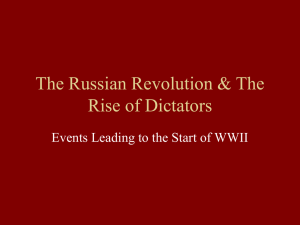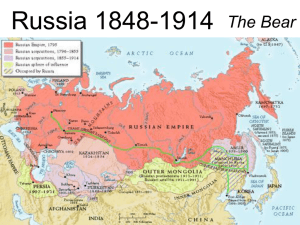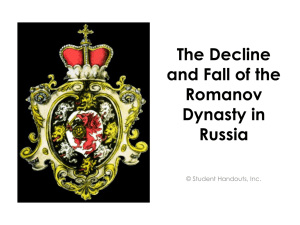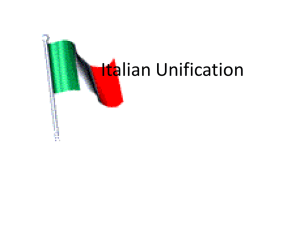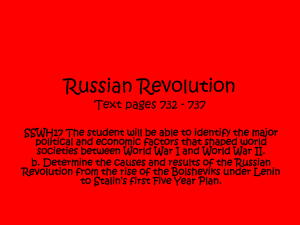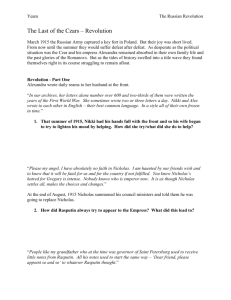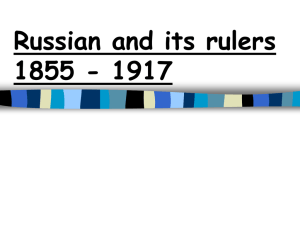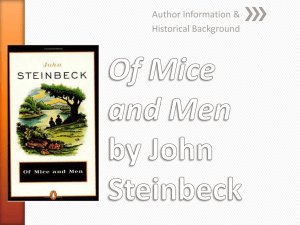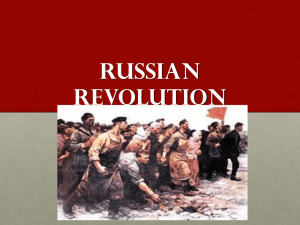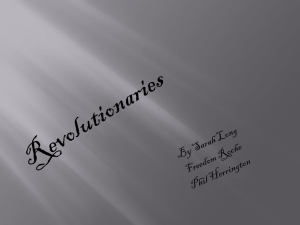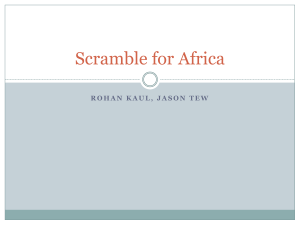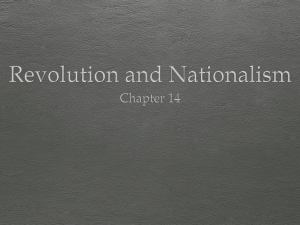The Russian Revolution
advertisement
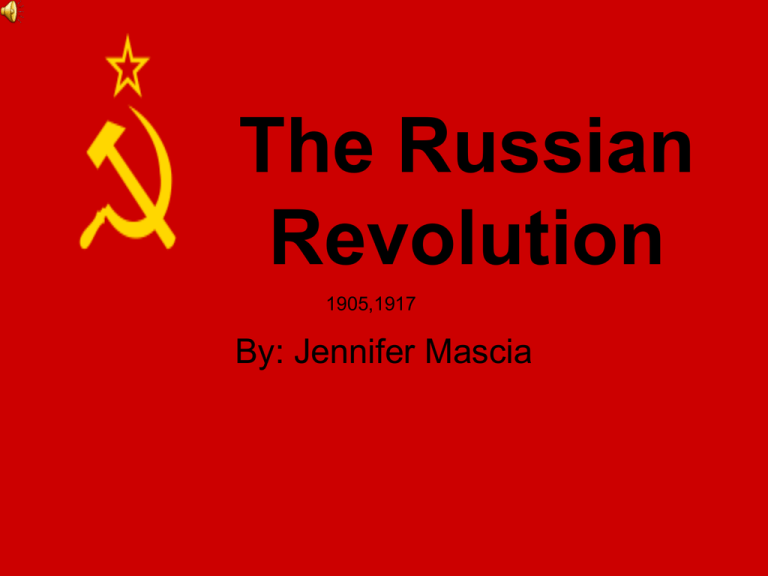
The Russian
Revolution
1905,1917
By: Jennifer Mascia
Background
• The reign of Czar
Alexander II (18551881) resulted in
widespread discontent
among the Russians
• Russian moral was
low after their defeat
in the Crimean War
Reforms of Alexander II
• March 3rd Emancipation Edict
– Left peasants unhappy with their
infertile land and high taxes paid to
the government for the land
• Zemstvas and Town Councils
– Gave the people more power to
govern themselves
– Resulted in liberalism which
challenged Czardom
• Reforms left the intellectual class
disappointed. They wanted to see more
radical reforms so they created
underground revolutionary societies that
aimed to overthrow the Czar.
– Nihilism-Czar & Orthodox Church must be
destroyed before new society could be created
– Populism-Russian peasantry would make a
socialist movement
• Split into two groups after 1871: Black Partition &
Will of the People
• March 13, 1881 Alexander II was assassinated by
members of the Will of the People
Reign of Czar Alexander III
(1881-1894)
• Aimed to counteract the reforms of his father
• He was autocratic and repressive and wanted
to crush the revolutionaries
• “Russification”. He wanted to bring Russia
back to pre-1861 times where the nobles
shared the power with the Czar
• During Alexander III’s
reign, the problems
among the peasants
and their landholdings
remained and the
revolutionary
movement was only
made more secret
instead of being done
away with.
• 1883 the first Russian
Marxist group was
formed in St.
Petersburg
Czar Nicholas II (1894-1917)
• 1894 Alexander
III died and his
son, Nicholas II,
became Czar
• He was weak
and indecisive
• Starting from the 1890s
and on, there were
massive worker strikes
under Nicholas’s reign.
• They wanted to protest
the intolerable working
conditions.
• They wanted economic
as well as political
reforms under the Czar.
Lenin
• In 1898 he formed the
Russian Social
Democratic Labor Party
• 1903 held a congress in
London
– Signified the split in the
Social Democratic party
– Bolsheviks (Lenin) &
Mensheviks
– The main difference
between the two is in the
number of people
(revolutionaries) who
would overthrow the
government
– The Split was formalized in
1905
Russo-Japanese War
1904
• Nicholas thought that if
Russia was successful in a
war, it would take the
people’s minds off revolution.
• Huge disaster for the Russian
government. Showed
inadequacy
• After the Russian defeat at
Yalu, the Minister of Interior,
Vyacheslav von Plehve, was
assassinated by Social
Revolutionary terrorists.
1st stage of revolution:
Bloody Sunday (January 22,1905)
• The Russian workers were now
angered by the losses in the war
as well as the continual labor
unrest and rise in food prices.
• Father Gapon, a pro-government
trade union organizer, took a list
of political and economic
demands to the Winter Palace.
Demands of Workers
• Political demands were the calling of
an elected Duma, freedom of speech
and assembly, guarantee of fair trials
and an amnesty for political
prisoners.
• Economic demands were more labor
legislation, the eight-hour day, a
reduction in indirect taxes and the
introduction of a graduated income
tax. The petition also demanded to
end the war immediately.
• The petition was signed by 135,000
persons.
•Thousands gathered peacefully and
expected to be granted their demands.
•Instead they were fired on by the
guards at the Winter Palace.
•More than 100 died and several 100
were wounded.
•The people now had lost complete
faith in their Czar
1905
• The Revolutionaries failed to overthrow
the Czar
• The problems carried over to the
revolution of 1917 where the will be
more successful
Russian Revolution of 1917
• After 1905, Nicholas went right back to
his autocratic ways.
• Any reforms he tried to put in place did
little for the struggling peasantry class.
• WWI was their breaking point.
The First Duma
• Lasted 73 days
• Consisted mainly of
people other than
nobles. They
demanded a
constitutional
monarchy.
• Nicholas soon
dissolved it.
• 2nd Duma met a similar
fate
Third (1907-1912) & Fourth
(1912-1917) Dumas
• Lasted for five years.
• Nicholas made it so that
revolutionaries didn’t make up the
majority.
• Octoberists and Monarchists did
• Socialists made up only about ¼
• The Duma grew more conservative
and the people grew angrier and
once again turned against Czardom
•In 1906, Stolypin became the Prime
Minister.
•Persecuted Jews, rioters, and
Finnish nationalists.
•Also exiled Lenin and other Social
Democrats.
•He abolished the communal system.
•It only made the situation better for the wealthy
peasants and not the lowest peasants.
•Some conditions improved such as
wages for the workers.
•1905-1909 the # of strikes and
revolutionary members declined
•Conditions were still bad and strikes
were considered illegal.
•Secret meetings were held between workers.
•Terrorism was also revived.
•Stolypin was assassinated
WWI
• In 1915, Nicholas left the capital city to act as
commander-in-chief in the field.
• This left the rule of Russia under the power
of his wife Czarina Alexandra.
• She then turned to the help of Rasputin
March Revolution
• The czarist regime collapsed under the
pressures and failures of Russians
involvement in WWI.
• Petrograd (St. Petersburg) troops were sent
to strikers demanding bread.
• The troops sided with the strikers instead.
• The Czar tried to suspend the session of the
Fourth Duma but it refused.
Abdication
• On March 15, 1917 Nicholas abdicated his
throne for his brother Michael.
• Michael decline the title and the Romanov
dynasty ended after three centuries of reign
(1613-1917).
• A Provisional Government was set up. The
Mensheviks and Social Revolutionaries
supported it
•Lenin came out of exile in April and
began his attack on the government
•The Provisional Government
continued the war effort.
•So the Social Revolutionaries and
the Mensheviks became despised
•This helped Lenin and the Bolsheviks rise and
popularity and eventually take over
October Revolution
• On October 20, 1917, Lenin decided to seize
power from the Provisional Government and
set up a “Military Revolutionary Committee”
• On November 7, in Petrograd, Lenin and his
Red Guards and Military Revolutionary
Committee led a coup d’etat.
• Under the Council of People’s Commissars
– Lenin was the Chairman
– Trotsky was the Commissar of Foreign Affairs
– Stalin was the Commissar of Nationalities
Sources
•
•
•
•
•
•
•
•
•
•
•
•
http://www.thecorner.org/hist/russia/revo1905.htm
http://www.thecorner.org/hist/russia/revo1917.htm
http://signaveritae.files.wordpress.com/2009/02/rasputin.jpg
http://www.tkinter.smig.net/QueenMarie/RecentBooks/BornToRule/images/Al
exandra.jpg
http://images.encarta.msn.com/xrefmedia/sharemed/targets/images/pho/t30
4/T304434A.jpg
http://www.white-history.com/hwr60_files/duma_1915.jpg
http://wpcontent.answers.com/wikipedia/commons/4/40/Vyacheslav_von_Ple
hve.jpg
http://pro.corbis.com/images/IH000454.jpg?size=67&uid={97410FCC-A9F64B35-B26C-A847305DD150}
http://upload.wikimedia.org/wikipedia/commons/e/ea/Alexander_III._Czar_Of
_Russia_Nadar.jpg
http://www.theosophycardiff.care4free.net/Nicholas%20II.jpg
http://net.lib.byu.edu/~rdh7/wwi/memoir/RusRev/images/rr19.jpg
http://www.bolshevik.org/graphic/lenin.jpg
